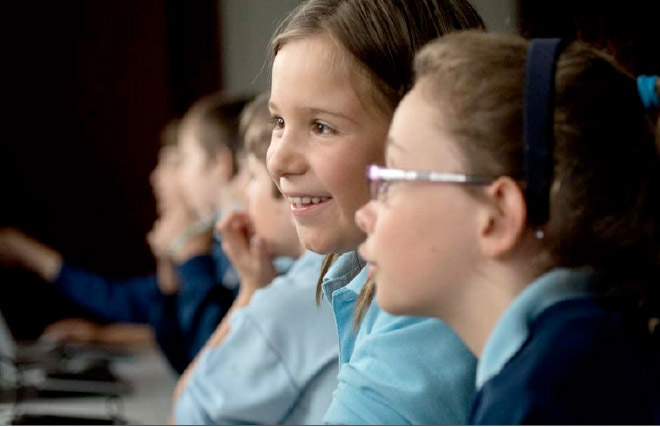St. Bernard’s Primary finds evidence boosts learning

It took some doing, but by taking time to have a good look at what was happening at St. Bernard’s Primary in Melbourne, the school has set itself on course for a more responsive, informed way of teaching and learning.
We’re all supposed to be using data to underpin practice but the problem is how. Having structure and intention is essential and St. Bernard’s has found these through John Hattie’s Visible Learning program Impact Process in partnership with Corwin.
St. Bernard’s is a co-educational primary school in Coburg, inner northern Melbourne, and a kaleidoscope of ethnicities, backgrounds and experiences. The school has 206 students with 40 different nationalities represented; 44.2% of students are from a Language Other Than English background.
Four years ago, St. Bernard’s, with its learning motto ‘where you are known’, saw the need to review the impact of learning success across the school community. In 2015, the school took part in a Collaborative Impact Program, which has transformed the school’s ability to ‘know thy impact’ through research, data and the rigour of employing effective instructional practices to ensure learning success.
After participating in the Visible Learning Foundation Day and Evidence into Action workshop series for school leaders, the significance of deliberately gathering evidence to evaluate impact on learning success became apparent. Evidence that moved beyond perceptions, to rigorous data supporting the school’s journey.
The two fundamental questions that underpinned discussions were:
1. What do we know about the impact we are having on ALL of our learners?
2. To what extent does data and evidence drive practice within the school?
Gathering and Analysing Evidence
The leadership team used a variety of Visible Learning evaluation tools to gather evidence. These included:
- An online self-assessment matrix, staff Mindframes surveys and two-way assessments of what students and staff were doing.
- Processes for identifying Visible Learners, i.e. what a good learner looked like, involved students and teachers developing a video diary.
- Students’ progress in reading and mathematics was investigated through standardised assessments to calculate effect size [i.e. Progressive Achievement Tests (PAT)] which provided progress information of student earning over time.
Through the Passionate and Inspired Teachers component a focus group of students provided their insights of what a good teacher looked like at St Bernard’s.
St. Bernard’s were also involved in a School Capability Assessment where an evaluation visit with the Corwin Team provided further evidence gathering and summaries of findings.
The collection and analysis of initial evidence identified their baseline statements. It was apparent that the students could not describe what or how they learned and PAT results were on average below a year’s growth, or an effect size of 0.4.
Teachers used praise as a means of feedback and the students identified that they were unsure of what to do when they made a mistake. The evidence also identified that learning leaders did not carry out walkthroughs and observations to consistently collect and use data to support decision making.
Our Aspiration
Through this evidence gathering process two aspirational statements were developed:
1. That all students understand and can articulate the characteristics of an effective learner.
2. That all students understand what they are learning, how they are going and where they are going to next.
Actions Taken
The first step was to develop a common language of learning across the school and to identify the school’s impact on all students. Staff undertook further professional development, both internally and in partnership with the Corwin Australia Professional Learning team.
The evidence gathered was presented and staff asked themselves the question, “How do we build our knowledge in order to know our impact?” Undertaking Visible Learning was a ‘just in time’ opportunity for St. Bernard’s.
The school had identified the need to investigate its aspirational statements but needed to explore its learning community at a deeper level, which the model of Visible Learning professional development and learning delivered.
Over the next 18 months, the school developed a language of learning through the investigation of what an assessment capable visible learner looked and sounded like. Staff debated what learning dispositions they wanted students to have and embedded the use of learning intentions and success criteria to bridge the learning gap and support effective use of the levels of feedback.
The Impact
Teachers at St. Bernard’s recall hearing Prof John Hattie (who developed Visible Learning) saying, “What if I have gotten it all wrong?” The St. Bernard’s school community is evidence that he wasn’t wrong. Visible Learning has combined the teaching group’s knowledge to enhance every learning opportunity.
Staff say that the Impact Process “has focused our energy on evidence informed and deliberate instructional practices that makes a real difference and we now know our impact on every student’s learning success. The opportunity to undertake Visible Learning has been transformational for our students, our staff and school community and our ongoing gathering and analysis of evidence continues to show us that our learners are making progress.”
St. Bernard’s now has
- A common language of learning
- Students who can clearly articulate their learning goals
- Students who identify mistakes as opportunities to deepen their learning
- Students who are exceeding expectations in school assessments and ask not only for their personal data, but feedback to support their next learning steps
- Staff who believe and know they are accountable for all student’s ‘effect size’ and growth
- Staff who can articulate where all students are and where to move them to next.